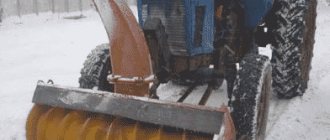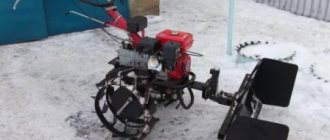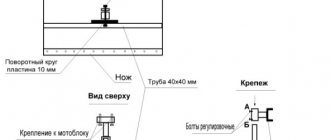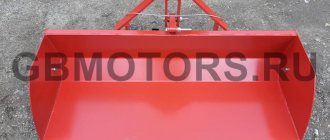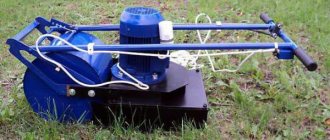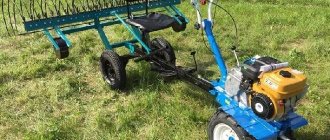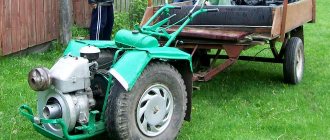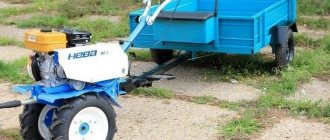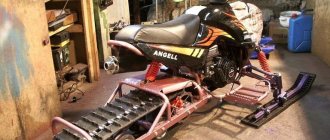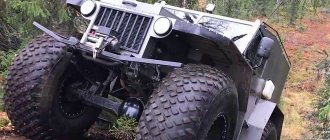The steel blade on the MTZ-82, included in the list of factory equipment, is designed for moving loose soil, gravel or ice. The owner of the equipment can assemble a bulldozer blade with his own hands, but this will require modifying the tractor’s hydraulic system and installing a control panel in the cab. There are homemade rotor-type structures designed to remove loose snow.
Purpose of the tractor blade
The structure, made of steel sheet with additional reinforcements, is intended for cleaning the road surface or for collecting soil (for example, during excavation work). A cutting element made of special steel is installed along the lower edge of the bulldozer element; on units for public works, a rubber lining is used to protect the road surface from damage (for example, when removing ice or snow). On MTZ wheeled tractors, the blade is mounted at the front; road machines are equipped with an additional scraper.
Universal municipal dumps
This equipment is used for collecting debris and clearing roads of snow of any density; they have various designs, including mechanical and hydraulic turning systems. The power of the load-bearing parts of the structure must correspond to the versatility of application from snow removal to soil leveling and storage of bulk materials of various densities. The lower part of the working plane can be equipped with either a rubber or composite bumper or a metal cutting bar, depending on the nature of the work being performed. Additionally, the kit may include attachments to increase the working height of the shovel when clearing areas of snow.
Universal utility dump
Types and design of the device
Categories and design features of dumps for MTZ-82:
- A unit for carrying out public works, characterized by reduced weight at the expense of strength. Suitable for removing light materials (e.g. debris or soft soil), can be used on agricultural farms.
- The bulldozer-type device is made of a thickened sheet, to which plates are welded to increase rigidity. The blade is used when carrying out road work or digging trenches.
- A snow shovel is distinguished by the absence of a cutting edge; it is used for cleaning yards and roads; the tool can be used when clearing an area of soft soil.
The characteristics of the dump using the example of a municipal 2-section unit NTU-10 are given in the table.
| Parameter | Meaning |
| Width, m | 2,0-2,6 |
| Productivity, m³ | up to 340 |
| Operating speed, km/h | up to 8 |
| Structure weight, kg | 600 |
| Cost, rub. | from 135 thousand |
Rotary milling snow blower
The milling rotary mechanism is in many ways similar to the rotary screw mechanism. Actually, they are often classified into the same category, but there are still some differences between them. The main one is that the auger spiral has pointed edges, i.e. is a cutter. Otherwise, the raking and ejection mechanisms are the same.
Thanks to the presence of a cutting edge, the rotary-milling snow blower copes well with icy snowdrifts, ice and crust. All the substance is ground into crumbs simultaneously with the intake, which allows cleaning areas at high speed. The productivity of the MTZ 80 for clearing snow with a rotary-milling snow blower can reach 800 t/h.
Most models are front mounted. This makes it possible to leave the rear mounted implement and speeds up the preparation of the machine for harvesting. For hanging from behind, the milling rotary SNT-2500 is produced.
The best models of rotary snow blowers
SU 2.1 and SU 2.5 OM
The SU 2.1 rotary milling snow blower is a worthy representative of this class. Among the advantages of the hitch are power and productivity, the ability to process even the most difficult icy material, quick installation, and the absence of the need for a creeper. The snow blower is installed at the front of the tractor, so it is possible to use the rear linkage at the same time.
SU 2.1 is designed to work in the harshest conditions. Thanks to the working width of 2.1, the mechanism will quickly remove snowdrifts even on a multi-lane road. But the hitch is mainly used for clearing snow on MTZ 82 in villages, since it is ideal for working on rough terrain (exits from highways, gravel roads, off-road).
The SU 2.1 snow blower is suitable for installation on MTZ 80 and 82. To work with the MTZ 1221, the SU 2.5 OM is available with a larger working width - 2.5 m.
Specifications:
| Milling rotary snow blower | SU 2.1/SU 2.5 OM |
| Suitable for tractors | MTZ-80 (82)/MTZ-1221 |
| Working width | 2.1/2.5 m |
| Performance | 50/80 t/h |
| Permissible snowdrift height | 1m |
| Release range | 1 – 25 m (controlled) |
| How many augers | 2 |
How does a blade work?
The blade is mounted on a subframe made of a steel profile, fixedly attached to the tractor frame.
To change the position of the structure and press the working edge to the ground, a 2-way hydraulic cylinder, controlled by a spool valve, is used.
Oil is supplied under pressure by a gear pump driven by an engine.
The tool has a rotating unit that allows you to place the knife at an angle to the longitudinal axis of symmetry of the machine (the position is changed manually or with a separate cylinder).
What to make a dump from
One of the main issues that need to be resolved when making a blade yourself is the selection of material and workpieces. Often the solution can be found from a pile of old scrap metal available on the farm or on the secondary iron market (at metal receiving yards or other enterprises).
For the manufacture of a working plane, a piece of large diameter pipe (1.2 -1.5 m) can be an ideal material. The thickness of the body of such pipes provides sufficient strength and rigidity, and the bending of the plane of the pipe part ideally matches the profile of standard factory dumps. In another option, you can use sheet metal of thickness corresponding to the purpose of the blade.
Making a blade from a large diameter pipe
The frame can be welded from any suitable material in the form of beams or tubular metal blanks with corresponding blanks. For example, old racks from the pointed tines of a cultivator can, with a certain blacksmith adjustment, be ideally suited for the vertical transverse stiffening ribs of the frame.
Example of frame manufacturing
You can make the hinged attachments of the blade to the hitch (pinned with pins) yourself, or use any ready-made ones from scrap metal. Such parts can be found in the articulated parts of cultivators and other agricultural machines.
For a knife, use any thick (from 15 mm) plate. Adjustment or extension of the body of the back side of the knife is carried out by welding on the reinforcement. The working edge is formed using a forge drawbar, followed by gentle hardening to increase wear resistance.
Bulldozer blades
Features of homemade equipment
The owner of a standard MTZ-82 tractor can independently make a blade from sheets of metal; to ensure functionality, it will be necessary to mount a hydraulic system. It is not recommended to install homemade equipment on equipment that is under warranty.
Due to overload, damage to structural parts may occur; in this case, the plant will refuse free repairs.
Before starting assembly, it is necessary to prepare drawings; it is recommended to assemble the unit in accordance with the dimensions and weight of the factory product.
Advantages and disadvantages
Advantages of a homemade blade for the MTZ tractor:
- low cost (compared to standard equipment);
- Possibility of manufacturing a structure with the required dimensions.
Disadvantages of products:
- assembly requires metal-cutting and welding equipment;
- it is necessary to purchase components for mounting the tool on the tractor;
- erroneous determination of dimensions leads to overload of the engine and chassis of the equipment;
- The lack of certificates makes it impossible to officially undergo a technical inspection.
Where is it used?
Homemade products are used by tractor owners in the following cases:
- for cleaning snow and dirt on personal plots;
- when performing earthworks;
- to clear a plot of land for the construction of a residential building or outbuildings;
- for moving crops (for example, grain).
Factors when choosing equipment
- The device must correspond to the intended use and power of the tractor, the mounting must correspond to the attachment
- For all types of equipment, attention is paid to the reliability of welds, fastening points, hinges and levers of the rotating mechanism, as well as the presence of lubrication points in the structure.
- In the working plane of the blade, the quality of the material and the reliability of the shovel frame are important. The plane material must be wear-resistant and shock-resistant and have sufficient elasticity. The components of the shovel - cutting bars, bumpers, attachments, in addition to their high wear resistance, must have reliable fastening and the possibility of convenient and quick replacement.
- Anti-corrosion coating is important for dumps used in snow removal, since, in addition to high humidity environments, additional corrosion is caused by the use of salt solutions when treating roads in urban environments. Loss of smoothness of the working plane of the blade will provoke freezing of snow or sticking of soil, reducing productivity.
- Pay attention to accessibility to components when performing repairs and maintenance of equipment, simplicity and reliability of connection to the attachment.
In snow shovels, do not be afraid to use reliable, lightweight composite materials that are resistant to corrosion, unlike metal ones.
What materials and tools will be needed
If the owner intends to make a blade with his own hands, then it is necessary to prepare:
- carbon steel sheet 8 mm thick for the manufacture of the main part of the scraper;
- steel channel for assembling the frame necessary for mounting the tool;
- double acting hydraulic cylinder;
- pipelines for connecting the cylinder to the pump;
- spool valve;
- swivel connectors;
- electric drill or drilling machine;
- tool for cutting steel profiles and sheets;
- welding machine;
- measuring and drawing tools;
- a thick rubber plate (in case of assembling a snow blower);
- mounting bolts and nuts (in accordance with the documentation).
Assembling a blade for a MTZ tractor
Possible designs of dumps for tractors:
- welded scraper with hydraulic control;
- steel structure with a rotor driven by an internal combustion engine;
- snow blower with electric power drive.
The easiest way
A brief algorithm for assembling a welded blade with hydraulic control:
- Mark the outline of the blade on a steel sheet, and then cut out the workpiece. It should be taken into account that the lateral extension of the scraper relative to the width of the tractor is allowed by no more than 400 mm to the side.
- Treat the edges with an abrasive tool, removing burrs.
- Drill 8-10 holes in the bottom to install the rubber plate. If the blade is not planned to be used as a snowplow, then leave the lower edge monolithic.
- Weld on the rear edge of the sheet the sections of channel necessary for installing the equipment on the subframe.
- Mark the steel profile and weld the subframe, which is attached to the front of the tractor through standard holes.
- Install the hinge joints, weld the joints and pre-install the structure on the tractor.
- Mark and weld brackets to which to attach the hydraulic cylinder for raising and lowering the blade.
- Route the hoses to the spool valve and connect the power drive to the tractor hydraulics.
- Tighten the threaded connections and check the operation of the unit; if distortions or jamming are detected, modify the design.
The manufactured blade has a flat scraper; it is impossible to bend a steel sheet evenly in artisanal conditions. There are designs made of several steel plates installed at an angle, allowing the blade to be used for loading soil or silage. Some owners provide the ability to change the angle of installation of the tool relative to the axis of the tractor. The adjustment is made by attaching adapters of different lengths; the oblique installation of the blade allows you to move soil or snow sideways when clearing the road, speeding up the cleaning procedure.
It is possible to manufacture a homemade design with a hydraulic cylinder that adjusts the angle of installation of the blade.
The subframe consists of 4 symmetrical elements, hinged on steel plates; a hydraulic drive allows you to raise and lower the hitch. A blade hinge and an auxiliary cylinder for deflecting the tool are installed on the front plate. A spool valve with additional sections is placed in the tractor driver’s cab, allowing stepless adjustment of the position of the blade in height and installation angle.
Sophisticated design with rotor
The basic design consists of a steel blade in which an auger is installed, driven by a separate gasoline engine (for example, from small agricultural equipment). The rotor must be mounted on ball bearings and balanced on a stand, otherwise the increased level of vibrations will not only destroy the blade, but also damage the structure of the tractor. A guide channel made of a thin steel sheet is inserted into the snow rotor circuit, which allows the collected ice to be thrown to the side. The equipment is not intended for soil cleaning.
MTZ tractors have a rear power take-off shaft, which rotates when the machine moves and is designed to drive attachments. The owner can make a structure for mounting on the rear of the vehicle, in which case there is no need to install an additional engine. The impeller and drive shafts require mandatory balancing.
Brief algorithm of actions:
- Make scrapers from a steel sheet, which must be welded at right angles. The design must ensure that snow is collected, which then falls on the rotating rotor and is thrown to the side.
- Install the amplifiers and mount the rubber plates along the lower edge.
- Make a rotor and a guide vane from a steel profile, allowing the collected material to be discharged into a separate channel. The impeller shaft is mounted on rolling bearings; a cardan shaft with a splined coupling must be provided between the blade and the tractor PTO.
- Weld a discharge pipe from a thin steel sheet, and then install the element above the rotor chamber.
- Install the equipment on the tractor and weld the eyes for attaching the hydraulic cylinder.
- Connect the actuator to the spool valve and gear pump of the tractor, and then secure the flexible hoses.
- Check the correct position of the elements and make sure that the equipment is working; if distortions or vibrations are detected, carry out modifications.
- Clean parts from traces of corrosion and cover with several layers of primer and impact-resistant enamel.
Homemade electric snow blower
The design is a rotary blade driven by an electric motor; a generator is installed on the tractor as a power source. Torque is transmitted from the power take-off shaft through an overdrive gearbox; the gear ratio depends on the design of the generator. The disadvantage of the product is the bulky design and increased fuel consumption due to double energy conversion. In addition, electrical circuits are under high voltage (220 or 380 V); creating such homemade structures is not recommended.
Snow removal rotor
Rotary snow blowers are modern, powerful and efficient devices that use rotational motion. This class includes many types of attachments, which can also be installed on the Belarus tractor.
Based on the principle of operation, rotors are divided into two groups:
- single stage,
- two-stage.
Single-stage rotors are combined cycle machines. They have one mechanism responsible for the development of the snow mass and its ejection. This group of snow blowers, in turn, is also divided into types:
- plow-rotor;
- milling rotary.
There are certain advantages to performing operations simultaneously. For example, the single-stage version has less weight. This has a positive effect on performance, fuel consumption and agility. In addition, the production of such a rotor for snow removal requires less metal, which means the unit will cost less.
Due to the reduced weight, the rotary snow blower places less load on the axle (for most models, the front axle). Thanks to this, transport speed increases, which is also important when working within the city and on busy highways.
Single-stage rotors for snow removal also have disadvantages. For example, combining several operations cannot be carried out without losing tractor power. For comparison: cutting a snow layer is performed at speeds of up to 10 m/s, and the energy intensity of this process is insignificant. At the same time, the ejection of waste material over long distances (for rotors, the ejection range can reach 20-50 m) is an energy-intensive process that consumes 2-3 times more power.
The two-stage rotor has a different operating principle. It has one mechanism responsible for the development of snow-ice substance, and the second for its ejection. As for the design, it can be:
- screw-rotor;
- milling-rotary.
Milling rotors can be either single-stage or two-stage.
For rotary snow blowers, a rotating auger is responsible for the fence. The massif is crushed using special blades located at the entrance to the chute. In milling-rotary attachments, the rotating element is a blade for clearing snow, which not only rake it in, but also immediately crushes it.
Single stage rotor EM-800
As an example of a simple single-stage rotor for snow removal on an MTZ 80 or 82, consider the EM-800. This is a front-mounted device that simultaneously performs two tasks: collecting snow mass and throwing it out.
The mechanism is mounted at the front and is powered by the Belarusian PTO. EM-800 is equipped with a fan rotor. A V-shaped blade is responsible for the fence, in the center of which there is a fan, and behind it is the entrance to the gutter. The rotating blades of the rotor cut off a certain volume and throw it into the chute at high speed. Next, the waste material flies out to the side, for which the pipe has a turn.
The rotary snow blower for MTZ 82 EM-800 has a simple design, therefore it is reliable and easy to maintain and operate. It is perfect for cleaning soft, freshly fallen snow. To work with frozen substances, it is better to choose a snow blower of a different design.
Specifications:
| Rotary snow blower | EM-800 |
| Suitable for tractors | MTZ-80/82 |
| Working width | 2.3 m |
| Performance | 200 t/h |
| Permissible snowdrift height | 1m |
| Release range | 15-40 m |
| How many rotors | 1 |
Summing up
To manufacture a blade for a tractor, welding and metal-cutting equipment is required; the tractor owner must have the skills of a designer and welder. A homemade design expands the capabilities of the equipment, but if there are errors in the calculations, the blade can damage the machine. It should be taken into account that when assembling scrapers of complex geometric configuration, the costs of materials and components increase. How can you save additional money and what designs of homemade dumps are used by owners for cleaning or clearing the territory?
